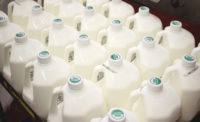Prior to joining Dairy Foods one year ago, I served as editor-in-chief of a music instrument magazine. The industry had been steadily strumming along, pun intended, for years, until a June 22, 2017 Washington Post article, titled: “Why my guitar gently weeps. The slow, secret death of the six-string electric. And why you should care.”
The story shook the industry at its core. Guitar manufacturers, as well as the trade organization, quickly scrambled to refute this story with data-backed evidence. The electric guitar did not die.
Once the pandemic started, guitar sales exploded as consumers suddenly had a lot of time at home with nothing better to do. The rest is history. Guitar sales can be considered healthy today.
Although perhaps not as dire in scope, an April 4 New York Times story titled “Got Milk? Not this Generation,” could be a seminal moment for the future of milk. It properly describes some of the biggest alleged problems for the industry, including “Americans’ annual milk consumption peaked at 45 gallons per person in 1945, according to the U.S. Department of Agriculture. It fell to about 23 gallons in 2001, and by 2021 it was down to 16 gallons,” the article states.
The story specifically focuses on Generation Z, defined as those born between 1997 and 2012, as a primary culprit for this decline. “Last year, members of Generation Z bought 20% less milk than the national average, according to the consumer market research company Circana,” the article reveals.
This statement is certainly accurate but does not tell the entire story. Not mentioned in this data, however, is the fact that this statistic is based on volume purchased, not household size. Gen Z typically has one to two people per household, whereas millennials and those in older demographics — such as myself in Generation X — drive up volume sales per buyer because they have larger average household sizes. Hence, their volume of purchase is naturally higher.
When we think about the Gen Z consumer, who is between 11 and 26 years old, it makes perfect sense that they are buying less than the national average as they are either still at home, in college, or in a transitional phase of life, whereas millennials are often starting families and buying for fuller households.
According to MilkPEP’s Attitudes and Consumption Trackers, conducted by Radius, which surveyed 2,400 in the Gen Z demographic:
- Eight in 10 teens had milk yesterday.
- While Gen Z accounts for 16% of the population, the generation consumed 20% of the milk in the United States in 2022.
- In 2022, more Gen Z teens (ages 13-17) and young adults (18-24) are still consuming milk on its own, in coffee/tea, in another beverage like smoothies, and in cereal as opposed to alternative dairy.
In addition, MilkPEP’s same research revealed:
- 80% of teens (ages 13-17) believe milk is “very healthy” or “extremely healthy.”
- 59% of teens (ages 13-17) agree that white milk provides several nutritional benefits vs. 38% believe oat milk does.
- A similar pattern can be seen in young adults (ages 18-24) with 53% agreeing white milk provides them with several nutritional benefits vs. 39% agreeing oat milk does.
Further, MilkPEP’s research found that Gen Z, and all generations for that matter, are not replacing dairy milk with alternative milk. They’re adding it to their fridges as an option for different occasions.
- Among young adults (18-24) 25% of households consume only milk and 63% consume both milk and alternative milk. Only 5% solely consume just milk alternatives.
- Among those dual milk and milk alternative households, 56% agree that “each has its place for different uses, and it wouldn’t occur to me to use milk alternatives as a replacement for dairy milk.”
Also important to note: Even if consumers are in fact cutting back on milk, they are not abandoning dairy. Circana data backs up these claims, which the article does allude to.
“All this is not to say that young people don’t eat plenty of cheese, yogurt, and ice cream. 'They’re not abandoning dairy,’” said John Crawford, a dairy analyst for Circana, in the story.
U.S. per capita dairy consumption sets a new record each calendar year. Consumption has increased 19% over the past 30 years, 9% over the past 15 years and 4% over the past five years. U.S. consumers have added 100 additional pounds of dairy to their diets over the past 30 years, from 560-plus pounds in 1992 to 660-plus pounds in 2021, according to the International Dairy Foods Association (IDFA).
Also, as IDFA’s Matt Herrick points out, more consumption of non-milk products can still be positive for milk processors. “It takes a lot of milk to make all that delicious and wholesome yogurt, cheese, butter, ice cream, protein shakes, and so much more,” he says. “On the fluid side, this is a product that is in more than 90% of U.S. homes. It is in every U.S. public school. It’s a success story that continues to write a new chapter with each generation.”
Certainly, reduced milk consumption is a long-term trend to be monitored. However, we are never returning to 1945. When we look at the complete dairy picture, all is not lost.




